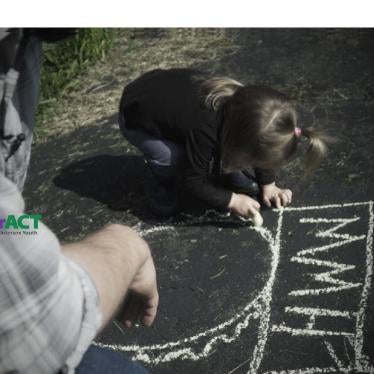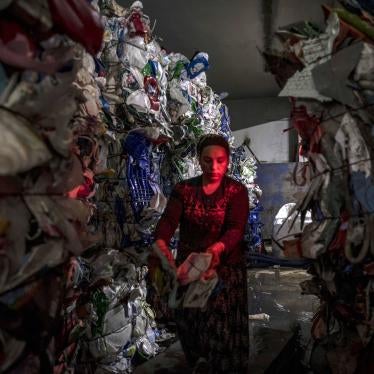(New York) – Syrian forces’ use of cluster munitions in residential areas is causing mounting civilian casualties, Human Rights Watch said today. An initial review of available information has identified at least 119 locations across Syria where at least 156 cluster bombs have been used in the past six months.
Human Rights Watch has investigated two cluster bomb attacks in the past two weeks – in Deir Jamal, near Aleppo and Talbiseh, near Homs – that have killed 11 civilians, including 2 women and 5 children, and wounded 27 others.
“Syria is expanding its relentless use of cluster munitions, a banned weapon, and civilians are paying the price with their lives and limbs,” said Steve Goose, director of the Arms division at Human Rights Watch. “The initial toll is only the beginning because cluster munitions often leave unexploded bomblets that kill and maim long afterward.”
On March 10, 2013, YouTube footage reportedly from Heish in Idlib showed a type of cluster munition remnant – the ShOAB-0.5 submunition – that is not known to have been used in the conflict before. The ShOAB-0.5 submunition is produced by the Soviet Union and is only known to be delivered by air-dropped RBK-500 cluster bombs.
Human Rights Watch has identified at least 119 locations in Syria where cluster munitions have been used in the period from August 2012 through mid-February. Several locations have been repeatedly attacked with cluster munitions, most notably al-Za`faraneh (near Rastan), as well as Abil (near Homs), Binnish (Idlib), Deir al-`Assafeer (near Damascus), Douma (near Damascus), and Talbiseh (Homs).
This information is derived from Human Rights Watch field investigations and from preliminary analysis of over 450 videos posted to the internet by activists since August. Remnants of at least 156 distinct cluster bombs have been identified so far from the video footage. Human Rights Watch has documented government use of cluster munitions, both air-dropped and ground-delivered, but it has seen no evidence of cluster munition use by opposition rebel groups.
For each video, or groups of videos documenting the same location, Human Rights Watch experts identified the type of cluster bomb and the type of explosive bomblets (also called submunitions) that apparently had been dropped by aircraft, including helicopters. This information provides an indication of the scale of cluster bomb use, but the data is incomplete as not all remnants are likely to have been recorded on video and the actual number of cluster bombs used in Syria is most likely much higher.
Human Rights Watch began to systematically collect and preserve the video evidence in October after initially identifying 35 strike sites attacked by at least 46 cluster munitions. In cooperation with the Brown Moses Blog, Human Rights Watch will make the entire collection of videos, supplemented by geographic coordinates and other analysis, available in a format compatible with the Information Management System for Mine Action (IMSMA) at a future date. This accounting will probably increase as more videos are collected and analyzed. The collection of data does not include recording casualties, but Human Rights Watch has documented numerous examples of civilian casualties from cluster munitions in Syria since mid-2012, including in October, November, and in January.
Forty percent of the 156 cluster bomb remnants have been identified as RBK-250 PTAB-2.5M cluster bombs, which are delivered by aircraft, including helicopters, and which break apart in mid-air to dispense 30 PTAB-2.5M high-explosive/anti-tank bomblets. Another type of cluster munition identified from the videos and research is the RBK-250 AO-1SCh cluster bomb, which disperses 150 AO-1SCh fragmentation bomblets. A total of 103 RBK-250 cluster bombs have been identified in the videos. In more than 50 other cases, remnants of a RBK cluster bomb were identified, such as its distinctive tail section, but there was not enough information to make an identification of the specific type.
A review of the markings on these bombs and the submunitions contained inside them, as well as a comparison with the Soviet manuals for the weapons, show that they were manufactured at Soviet state munitions factories in the 1970s and early 1980s. There is no information available on how or when Syria acquired these cluster munitions, which were made in the former Soviet Union.
In January, Human Rights Watch documented civilian casualties caused by Syrian government use of another type of cluster munition, the Egyptian-made 122mm SAKR surface-launched rocket containing dual-purpose antipersonnel/anti-materiel bomblets. This was the first known instance of Syrian use of ground-based cluster munitions in the conflict.
On March 10, local activists uploaded video footage reportedly shot in the village of Heish in Idlib governorate showing a submunition that failed to function (explode) on impact. The video was subsequently uploaded online by Edlib News Network, a group of Idlib based activists. Human Rights Watch has identified it as a ShOAB-0.5 fragmentation submunition, a tennis-ball-shaped submunition produced by the Soviet Union that is only known to be delivered by air-dropped RBK-500 cluster bombs. The RBK-500 cluster bomb and ShOAB-0.5 submunition are not known to have been used previously in Syria.
The ShOAB-0.5 submunition is a direct copy of the BLU-26 submunition produced by the United States and used extensively in Southeast Asia in the 1960s and 1970s. Jane’s Information Group, a publishing company specializing in military topics, lists Syria as possessing RBK-250-275 and RBK-500 cluster bombs. According to international reference manuals one version of the RBK-500 cluster bomb is reported to contain a total of 565 ShOAB-0.5 submunitions. This is the fourth type of cluster munition to have been identified in the conflict.
Recent Attacks on Deir Jamal and Talbiseh
In the past two weeks, Human Rights Watch has investigated civilian casualties from two cluster bomb attacks, at locations in Homs and Aleppo governorates. Based on interviews with witnesses, analysis of videos posted online by local activists, and photographs taken at the scene, Human Rights Watch has concluded that a cluster bomb attack on Deir Jamal in Aleppo on February 28 killed 2 women and 5 children from the same family and injured a man, while another cluster bomb attack on Talbiseh in Homs on March 2 killed 4 and wounded 26 civilians, including 6 women and 7 children.
Human Rights Watch visited Deir Jamal on March 6 and 7 to investigate the air strikes, interviewing witnesses and photographing cluster bomb remnants.
A resident who lived next to a home destroyed in the attack told Human Rights Watch that he was 700 meters away from his house in the village at around 12:30 p.m. on February 28 when he saw a jet flying low that started dropping ordnance. He heard explosions and headed toward the site of the attack, the home of his neighbors, the Dabbas family. The witness said that he helped retrieve five bodies, while two more bodies were retrieved later. Another resident told Human Rights Watch that he was one kilometer away in the village at the time and saw a jet plane dropping ordnance. He went to the Dabbas family home, where he said he saw bodies and “pieces of bodies” of two women and five children.
A community leader identified the victims as: Malak Muhamad Akil, 40; Jinan Abdul Hameed Dabbas, 22; Muhamd Ali Ahmad Dabbas, 12; Haydar Ahmad Dabbas, 10; Maryam Ahmad Dabbas, 3; Ali Hasan Dabbas, 3, and Hamzeh Hasan Dabbas, 1. In addition, Human Rights Watch identified a local man who was wounded in the attack.
Most of the 7,000 inhabitants of Deir Jamal had already left the village after extensive shelling and air strikes, leaving only about 60 civilians when Human Rights Watch visited, in addition to some opposition Free Syrian Army troops. The distance from the FSA base to the Dabbas family home is about 300 meters, while the front line is approximately 13 kilometers away.
Human Rights Watch photographed remnants of the cluster bomb that hit the Dabbas home and another bomb that fell nearby. Witnesses said that three more cluster bombs fell in the northern and eastern parts of the village. From the photographs, Human Rights Watch has identified the remnants of a RBK-250-275 cluster bomb containing AO-1SCh fragmentation bomblets. There are 150 bomblets in each of this type of cluster bomb.
On March 2, a local activist in Talbiseh recorded video footage (subsequently uploaded online by the Committee to Protect Civilians-Talbiseh) of a cluster bomb attack on his neighborhood in the northern suburbs. Human Rights Watch interviewed the activist to corroborate the video evidence. The video captures the cluster bomb strike as it happens, showing the munition break apart and scatter submunitions, including some that fail to explode and bounce toward the camera. The activist described the attack to Human Rights Watch:
I was walking around in Talbiseh. … My camera is always on. I never turn it off because you never know when you will use it. When I reached the square in the center of Talbiseh I heard the sound of an explosion in the air and then explosions on the ground just in front of me. I heard another explosion, but the sound came from further away.
I heard people screaming. I ran toward them and found out that one of the streets where the bomblets dispersed had people in it at the time. When I reached the house, I saw heavily wounded children inside. The children had been inside the house when the bomblets entered the walls and exploded. After helping out the injured we found three people killed in one of the nearby houses. They were from the same family. The bomblet exploded next to them, we saw remnants. I was told that a fourth man was also found killed on the street. I think he was walking at the time.
We found several unexploded bomblets. I don’t remember the exact number. The bomblets from the two bombs dispersed over seven streets and the first three streets were the most damaged and were populated at the time. The bomblets created small holes on the ground and on walls of houses. The cluster bomb explosion that you see in the video caused several injuries and casualties. The second cluster bomb attack, 500 meters away from the first one, did not cause any civilian damage because it fell in an area with no residents.
In total, the cluster bomb attack on March 2 killed at least four men, all civilians according to the activist, and wounded 26 people. The activist visited the local field hospital after the attack, where he said he counted the 26 wounded civilians, including 7 children and 6 women. He said that four men injured in the attack appeared to be in critical condition with internal bleeding caused by shrapnel. “The field hospital is not equipped so the medical team could not perform surgeries and at the same time we could not evacuate the wounded because of the siege imposed by the Syrian army,” the activist said.
The four men killed as a result of the cluster bomb attack were: Abdel Rahman al-Masri, Ahmad Swaiss, Selim Mohamad Miznazi, and Mohamed Abdel al-Kafi al-Mer`I.
From video footage uploaded online by the Network of Syrian Revolution News in Talbiseh, a group of Talbiseh activists, of remnants and description by the activist, Human Rights Watch has identified the remnants of a RBK cluster bomb canister.
Unexploded submunitions and other remnants left from the cluster bomb attack pose a deadly risk to those who handle them. The witness said: “An hour after the bomb canister hit the ground part of it exploded … but didn’t cause any injuries.”
The activist said that the Free Syrian Army troops were based one kilometer away from the site of the attack. “FSA brigades are only located around the town, which is seen as the frontline between them and the army,” he said. “They don’t have any vehicles inside the town and as you can see in the video all the people were civilians and the FSA was not present. Liwa` al Islam [an armed opposition group] is very active in Talbiseh. … Following the cluster bomb attack, tank shelling started.”
According to the activist, approximately one-third of Talbiseh residents had left the town after their homes were destroyed by shelling, but internally displaced residents from Homs had relocated to Talbiseh. “The regime knows that Talbiseh is a populated area,” he said. “The Syrian army now has surrounded us from all sides, making it harder to leave the town. We are stuck here.”
International Law
A majority of the world’s nations have comprehensively banned the use of cluster munitions through the Convention on Cluster Munitions, which came into force on August 1, 2010. Syria is not a party to the convention and did not participate in the 2007-2008 Oslo Process that led to the creation of the treaty, which bans cluster munitions and requires clearance of contaminated areas and assistance to victims. A total of 79 countries are party to the Convention on Cluster Munitions, while another 32 have signed but not yet ratified.
Countries that have joined the Convention on Cluster Munitions are obliged to promote the norms that the convention establishes against cluster munitions and to “make its best efforts to discourage states not party to this Convention from using cluster munitions,” according to Article 21(2). Fourteen states parties have condemned Syria’s use of cluster munitions, including Austria, Belgium, Denmark, France, Germany, Ireland, Japan, Mexico, Netherlands, New Zealand, Norway, Portugal, Switzerland, and the United Kingdom, while non-states parties Qatar and the United States have also done so.
Human Rights Watch is a founding member of the international Cluster Munition Coalition, the civil society campaign behind the Convention on Cluster Munitions.
“All nations that have joined the treaty banning cluster bombs have a legal obligation to speak out and condemn Syria’s ever-expanding use of these indiscriminate weapons, yet too few are doing so,” Goose said. “If there was ever a time to speak out it is now. We urge all nations that care about the protection of civilians to condemn Syria’s cluster bomb assaults in the strongest possible terms.”







